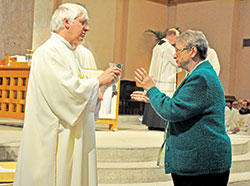Parishes can offer the precious blood in Communion starting on the first Sunday of Advent

Deacon Richard Cooper of St. Mary Parish in Lanesville offers the precious blood in Communion on March 31, 2015, in SS. Peter and Paul Cathedral in Indianapolis during the annual archdiocesan chrism Mass. (Criterion file photo by Sean Gallagher)
By Sean Gallagher
Beginning with Mass for the first Sunday of Advent on Nov. 26-27, archdiocesan parishes may reintroduce offering the precious blood at Communion.
This practice was suspended across the Church in central and southern Indiana more than two years ago at the start of the COVID-19 pandemic in March 2020.
An e-mail sent on Nov. 2 to pastors, parish life coordinators and religious superiors across the archdiocese from the archdiocesan Office of Worship explained the reintroduction of the offering of the precious blood in this way:
“Other than as a part of the precautions observed during the pandemic, the distribution and reception of holy Communion under both kinds has been the practice in the parishes and institutions of the Archdiocese of Indianapolis for over 35 years to the benefit of our local Church,” the e-mail read. “Archbishop [Charles C.] Thompson is again permitting the reception of holy Communion under both kinds at any Mass where it can be done according to the Church’s instruction.”
Father Patrick Beidelman, executive director of the archdiocesan secretariat for worship and evangelization, said that he has received an increasing number of requests from parishes to consider restoring offering the precious blood.
While some faith communities are interested in reintroducing this practice soon, Father Beidelman recognizes that this won’t be the case in all archdiocesan parishes.
“We want parishes to have that flexibility to make the decision at the local level when they are able to do it,” he said. “Some may postpone it just because logistically they need to re-activate their extraordinary ministers of holy Communion, do a little bit of renewal, do a little catechesis with the parish.”
At the same time, Father Beidelman is gratified that parishes will be able to offer anew the precious blood at Mass in the archdiocese.
He noted that the U.S. bishops’ 2002 “Norms for the Distribution and Reception of Holy Communion under both Kinds” explains well the benefit of having Communion available under the appearance of both bread and wine:
“Holy Communion has a more complete form as a sign when it is received under both kinds. For in this manner of reception a fuller sign of the Eucharistic banquet shines forth.”
Father Beidelman also said that the reintroduction of offering the precious blood in Communion in archdiocesan parishes comes at a good time as the Church in central and southern Indiana is participating with dioceses across the country in the first of the three years of the National Eucharistic Revival.
“Because the eucharistic revival is striving to cultivate a deeper and more vibrant relationship with Jesus Christ in the Eucharist,” he said, “having the more complete form of Communion as a sign with the offering of the precious blood can allow the eucharistic banquet to be a fuller experience of the presence of Christ and can connect us with the heavenly banquet to which we are all called.”
(For information on the history and theology of offering the precious blood in Communion, go to www.archindy.org/worship/communion.html.) †
